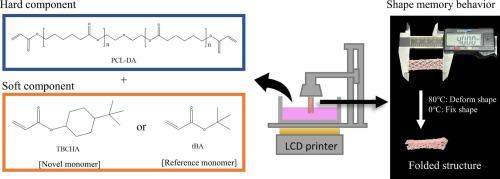用于4D打印的高性能生物相容性形状记忆聚合物:4-叔丁基丙烯酸环己酯作为软组分单体的效果
IF 6.3
2区 化学
Q1 POLYMER SCIENCE
引用次数: 0
摘要
本研究以丙烯酸叔丁酯(tBA)为基准材料,探讨了叔丁基环己基丙烯酸酯(TBCHA)作为一种新型软段单体在4D可打印形状记忆聚合物(SMPs)开发中的潜力。以合成的聚己内酯二丙烯酸酯(PCL-DA)为交联剂,以4-叔丁基环己基丙烯酸酯(TBCHA)或丙烯酸叔丁酯(tBA)为单体,以3wt %的二苯基(2,4,6-三甲基苯甲酰)氧化膦(TPO)为光引发剂,制备了高拉伸性SMP树脂。然后,使用液晶显示器(LCD) 3D打印机打印SMP。通过单体含量的系统性变化来评估可印刷性、机械性能、热行为、形状记忆性能和生物相容性。与基于tba的网络相比,基于tbcha的网络具有更低的聚合收缩率,更高的硬度,更高的抗拉强度,以及更好的形状固定性和回收率。这些改进归功于TBCHA中环己基环的构象柔韧性,这促进了光聚合过程中有效的应力松弛和更高程度的转化。动态力学分析(DMA)和差示扫描量热法(DSC)表明,TBCHA体系具有较高的玻璃化转变温度(Tg)和存储模量,这与TBCHA体系优异的力学性能有关。此外,MTT实验证实了基于tbcha的SMPs的细胞相容性,降解研究表明,当加入PCL-DA时,SMPs的水解降解行为可调节。总的来说,这项工作确立了TBCHA作为先进SMP应用的有前途的单体,为生物医学和功能材料领域的4D打印技术提供了一个多功能平台。本文章由计算机程序翻译,如有差异,请以英文原文为准。

High-Performance biocompatible shape memory polymers for 4D Printing: Effects of 4-tert-Butylcyclohexyl acrylate as a soft component monomer
This study explores the potential of tert-butylcyclohexyl acrylate (TBCHA) as a novel soft-segment monomer in the development of 4D printable shape memory polymers (SMPs), using tert-butyl acrylate (tBA) as a reference material. The highly stretchable SMP resin was prepared by mixing synthesized polycaprolactone diacrylate (PCL-DA) as a crosslinker, 4-tert-Butylcyclohexyl acrylate (TBCHA) or tert-butyl acrylate (tBA) as a monomer, and 3 wt% of diphenyl(2,4,6-trimethylbenzoyl) phosphine oxide (TPO) as a photoinitiator. Then, the SMP was printed by using a Liquid-Crystal Display (LCD) 3D printer. With systematic variation in monomer content to evaluate printability, mechanical properties, thermal behavior, shape memory performance, and biocompatibility. The TBCHA-based networks demonstrated lower polymerization shrinkage, higher hardness, greater tensile strength, and improved shape fixity and recovery ratios compared to tBA-based counterparts. These improvements are attributed to the conformational flexibility of the cyclohexyl ring in TBCHA, which promotes efficient stress relaxation and a higher degree of conversion during photopolymerization. Dynamic mechanical analysis (DMA) and differential scanning calorimetry (DSC) revealed higher glass transition temperatures (Tg), which close to body temperature, and storage modulus in TBCHA systems, correlating with their superior mechanical performance. Furthermore, MTT assays confirmed the cytocompatibility of TBCHA-based SMPs, and degradation studies showed tunable hydrolytic degradation behavior when PCL-DA was incorporated. Collectively, this work establishes TBCHA as a promising monomer for advanced SMP applications, offering a versatile platform for 4D printing technologies in biomedical and functional material fields.
求助全文
通过发布文献求助,成功后即可免费获取论文全文。
去求助
来源期刊

European Polymer Journal
化学-高分子科学
CiteScore
9.90
自引率
10.00%
发文量
691
审稿时长
23 days
期刊介绍:
European Polymer Journal is dedicated to publishing work on fundamental and applied polymer chemistry and macromolecular materials. The journal covers all aspects of polymer synthesis, including polymerization mechanisms and chemical functional transformations, with a focus on novel polymers and the relationships between molecular structure and polymer properties. In addition, we welcome submissions on bio-based or renewable polymers, stimuli-responsive systems and polymer bio-hybrids. European Polymer Journal also publishes research on the biomedical application of polymers, including drug delivery and regenerative medicine. The main scope is covered but not limited to the following core research areas:
Polymer synthesis and functionalization
• Novel synthetic routes for polymerization, functional modification, controlled/living polymerization and precision polymers.
Stimuli-responsive polymers
• Including shape memory and self-healing polymers.
Supramolecular polymers and self-assembly
• Molecular recognition and higher order polymer structures.
Renewable and sustainable polymers
• Bio-based, biodegradable and anti-microbial polymers and polymeric bio-nanocomposites.
Polymers at interfaces and surfaces
• Chemistry and engineering of surfaces with biological relevance, including patterning, antifouling polymers and polymers for membrane applications.
Biomedical applications and nanomedicine
• Polymers for regenerative medicine, drug delivery molecular release and gene therapy
The scope of European Polymer Journal no longer includes Polymer Physics.
 求助内容:
求助内容: 应助结果提醒方式:
应助结果提醒方式:


